Honda has a pricing problem. If it wasn’t clear enough when they introduced the Honda Civic back in January 2022 at the price of Rs 60 lakh (which has since risen to the Rs 1 crore mark), it should by now have become a player with how Honda has handled their latest attempt at rejuvenation: The HR-V.
As a car it is one you would expect to do well. It boasts the distinction of being the first indigenously produced Japanese crossover-sports utility vehicle (C-SUV) in Pakistan. Not only this, the HR-V was the first C-SUV launched by one of the “Big Three” (Suzuki, Toyota, and Honda) car companies in Pakistan. The hype surrounding it was justified, and Honda hit the ground running with it. The vehicle was fully booked for the first six months merely a day after its launch.
But that is all in the past.
Sales of the car have since nosedived. It has also tanked on the secondary market making it an undesirable car in terms of resale value. This fall has been bad enough that the HR-V is now being sold on interest free instalments in a two year plan. That is how desperate Honda seems to have gotten to wash their hands of the car. So what went wrong?
The Vezel psyche
Our story starts with a different car in a different era. Back in 2014-15, the Pakistani car market was facing an influx of refurbished Japanese cars. The Toyota Vitz was possibly the most successful of these cars but there were other iconic four wheelers too. The Toyota Passo and Prius were both famous on this market as well. But Honda’s contribution to this was the Vezel.
Vezel is the name that the HR-V has on the Japanese domestic market. At the time, a Honda Vezel in good shape would sell at a range of Rs 35 lakh to Rs 36 lakh at a time when the Toyota Corolla and Honda Civic were around Rs 10 lakhs cheaper than this. But the Vezel was not a sedan. As one of the first crossover SUVs to hit the Pakistani market it immediately made its place in the car circuit in Pakistan. In fact, the Vezel was an early herald to another iconic car: The KIA Sportage which hit markets in 2020.

Before Lucky Motors heralded the arrival of the KIA Sportage, Pakistan’s C-SUV landscape was barren, compelling consumers to depend on an assortment of imported vehicles to bridge the market void. The nonexistence of a C-SUV at the in Pakistan did not signify a dearth of demand for one. The Vezel was the precursor of the Sportage, and the C-SUV sensation. By 2014-15, consumers had grown familiar with auction sheets, a development that coincided with Pakistan’s resolution to peg its currency to the dollar. These elements collectively fuelled the Vezel’s meteoric rise in popularity. So much so that Honda launched the global rendition of the Vezel, the HR-V, in 2016.
The 2016 HR-V was a completely built-up unit (CBU) — a fully imported entity — whereas the current version is a completely knocked down (CKD) unit. Consequently, the 2016 HR-V does not lay claim to the accolade of being the inaugural locally manufactured Japanese C-SUV. That distinction is reserved for the present iteration. The fact that the 2016 model failed to secure this honour, despite its launch over half a decade ago, speaks volumes about the market’s reception of the vehicle.
The CBU HR-V’s debut in Pakistan in January 2016 was met with lukewarm response, as the vehicle was under-equipped and overpriced in comparison to the Vezel offered by importers. To provide some context, the Vezel was a hybrid, equipped with a 1.5-litre internal combustion engine and a 30 hp electric motor. The HR-V, in contrast, was fitted with a standard 1.5-litre internal combustion engine — identical to the engine powering the more budget-friendly Honda City at the time. The HR-V bore a price tag of approximately Rs 36 lakh, while the Vezel was priced at Rs 34 lakh. The Vezel also enjoyed the benefits of superior quality of life features and enhanced build quality. Ultimately, by 2018, Honda decided to discontinue the HR-V altogether.
The relaunch
Despite all this, Honda knew that the HR-V had the potential to be a big seller. They also knew that to have the best shot at selling it they would have to introduce the latest shape, model, and make of the car to convince people to buy it. In October 2022 the HR-V had a successful launch. Merely a day post-launch, the company was inundated with bookings stretching well into the early months of the following year. Within a week, whispers began to circulate that the vehicle was sold out until spring, and perhaps even beyond.
However, charting the HR-V’s triumphant trajectory is no simple task. Honda, in its monthly sales report to the Pakistan Automotive Manufacturers Association (PAMA), merges the HR-V’s sales figures with those of the BR-V. Consequently, discerning the individual sales of each model becomes a challenge. While some third-party reports provide inklings about the composition of Honda’s sales, the company itself remains tight-lipped, leaving everyone in a state of speculation. We find ourselves in the same boat.

Our analysis delved into the five-year history, spanning from September 2019 to September 2023, of the HR-V/BR-V category in Honda’s sales filing to PAMA. Our objective was to gauge the growth in sales volume of the category since the HR-V’s introduction. The combined category of the HR-V, and BR-V accounted for a total of 2,962 vehicles sold from January 2022 to October 2022. In stark contrast, from November 2022 to March 2023, the category registered 3,262 sales, marking a 10% increase in half the time. Furthermore, when examining the category’s sales relative to the entire car category, the category represented a modest 2% of total sales on average from January 2022 to October 2022. However, from November 2022 to March 2023, it ascended to 5%.
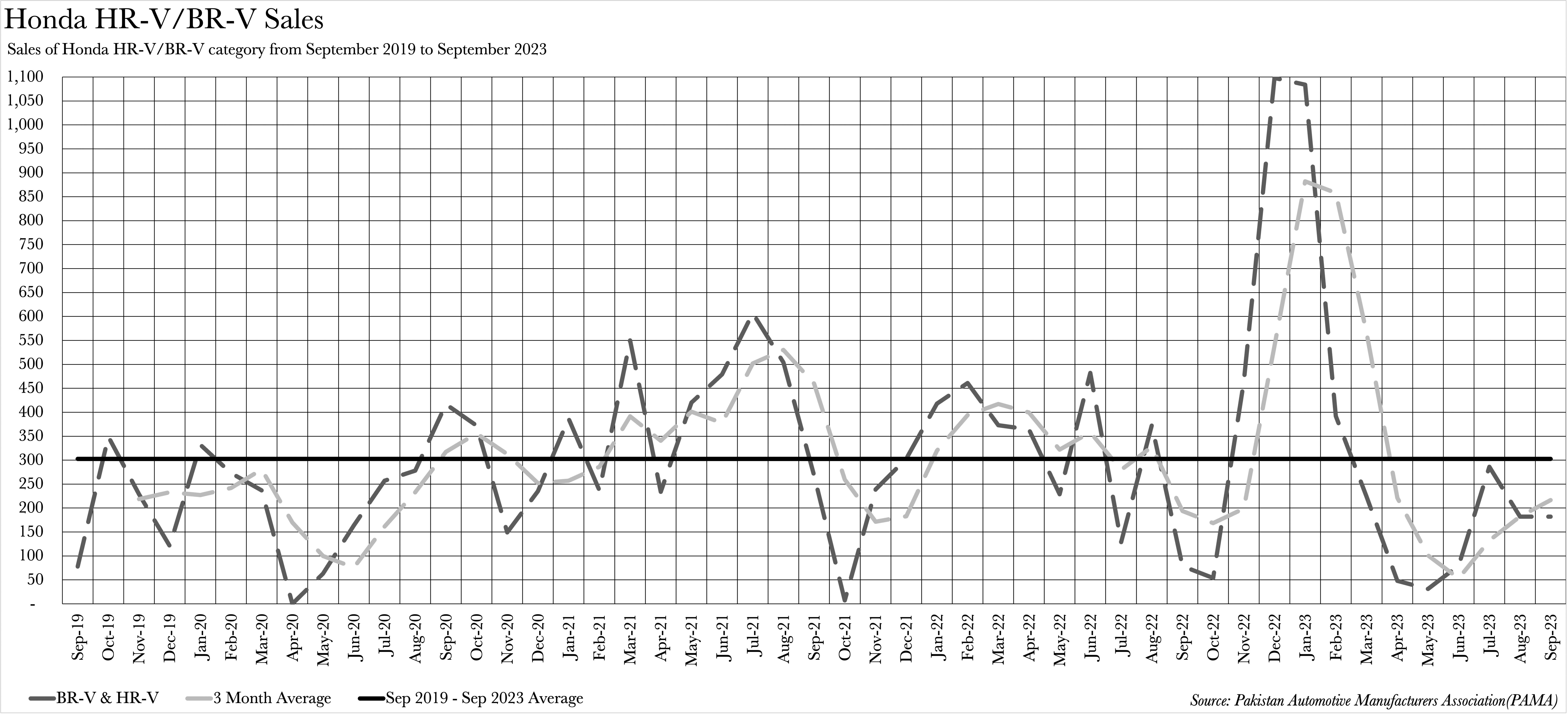 In the absence of disaggregated sales figures, one could surmise that the surge in sales was due to the BR-V overshadowing the HR-V in terms of general interest. Yet, a cursory glance at Google Trends reveals that the HR-V has consistently piqued more interest than the BR-V for the majority of the time from September of the previous year until now, with the HR-V only recently descending to interest levels comparable to the BR-V. This is where our problem lies, and the second part of our story begins.
In the absence of disaggregated sales figures, one could surmise that the surge in sales was due to the BR-V overshadowing the HR-V in terms of general interest. Yet, a cursory glance at Google Trends reveals that the HR-V has consistently piqued more interest than the BR-V for the majority of the time from September of the previous year until now, with the HR-V only recently descending to interest levels comparable to the BR-V. This is where our problem lies, and the second part of our story begins.
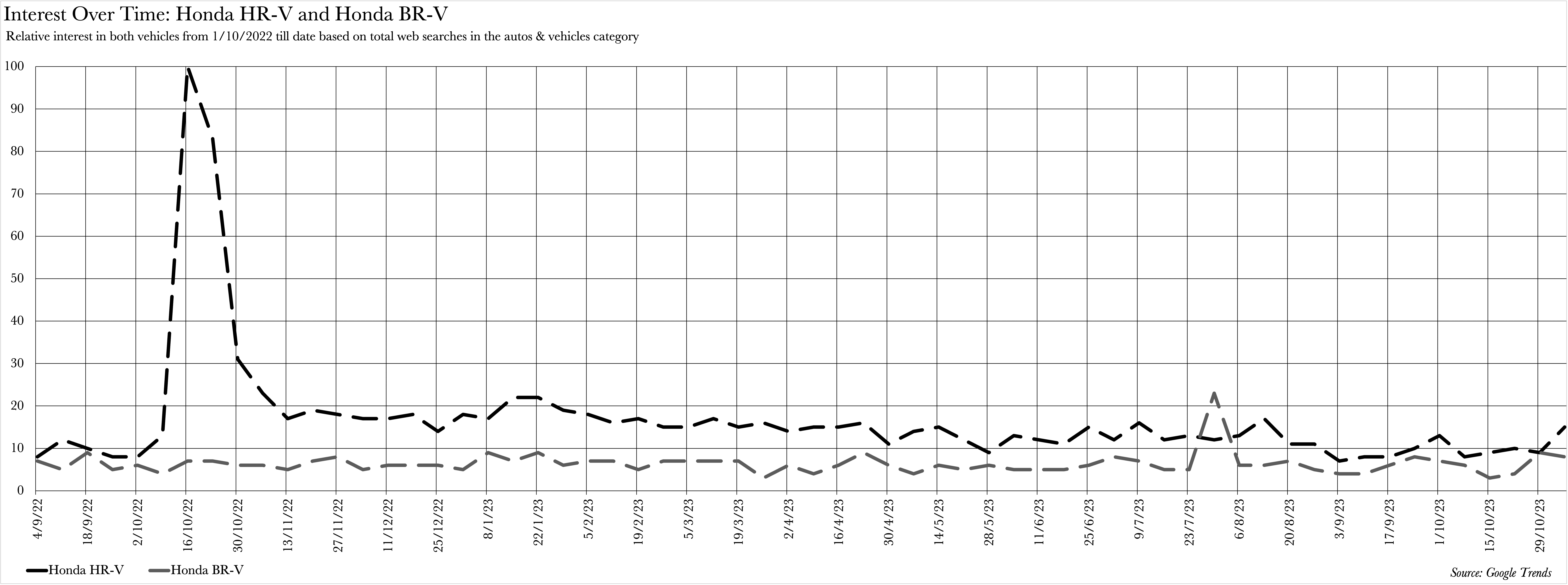 While the HR-V made a spectacular debut, it appears to have lost its initial momentum. In terms of nominal sales, sales relative to the entire car market, and sales relative to Honda’s portfolio alone, the aforementioned dual category has experienced a significant downturn. The HR-V and BR-V category, based on PAMA’s sales figures until September of this year, is actually trailing the average sales for the category from September 2019 to date. This trend has been evident since February 2023.
While the HR-V made a spectacular debut, it appears to have lost its initial momentum. In terms of nominal sales, sales relative to the entire car market, and sales relative to Honda’s portfolio alone, the aforementioned dual category has experienced a significant downturn. The HR-V and BR-V category, based on PAMA’s sales figures until September of this year, is actually trailing the average sales for the category from September 2019 to date. This trend has been evident since February 2023.
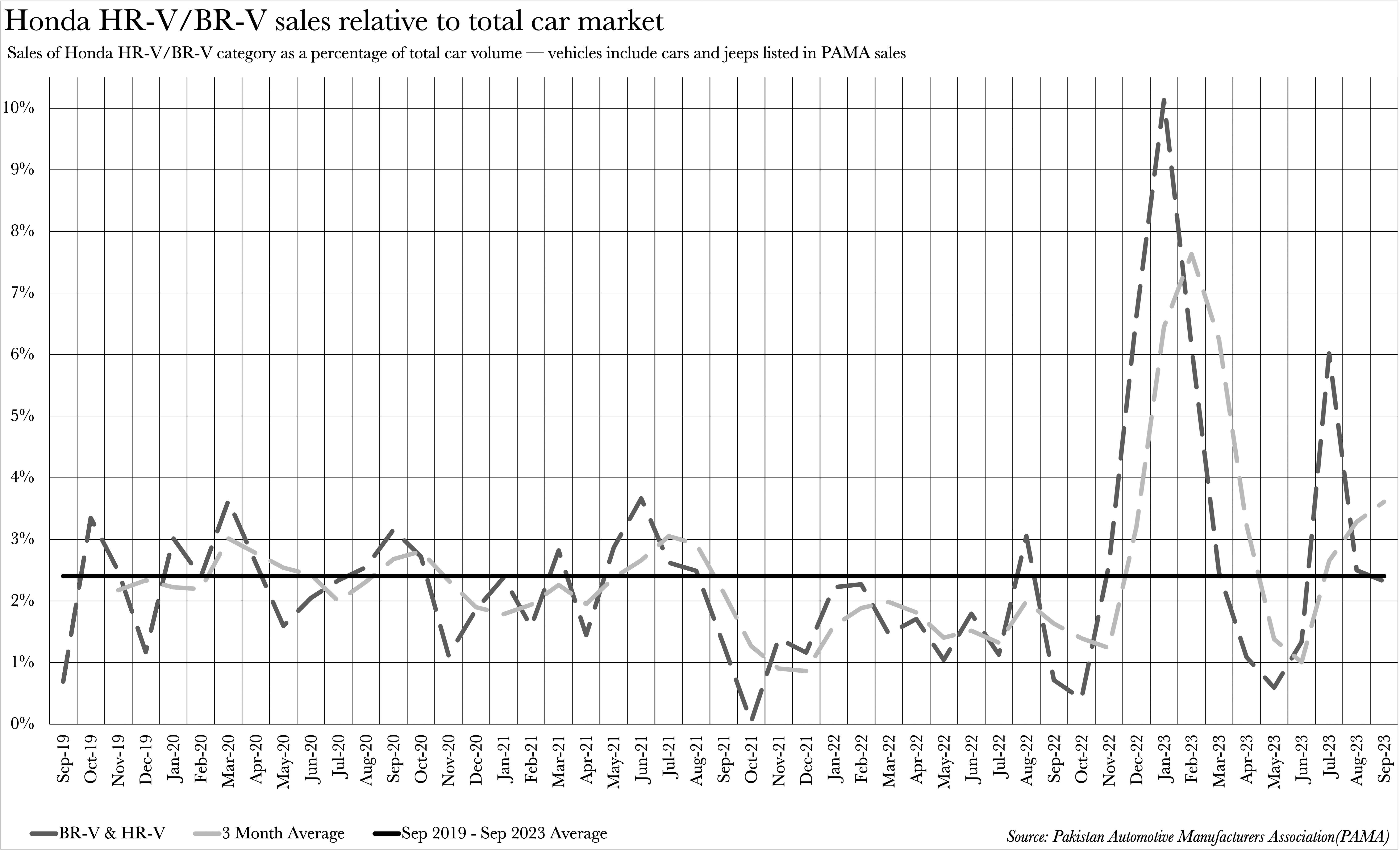 Nominal figures might be deceptive, given the current turbulence in the automotive industry, but the narrative remains consistent in terms of relative sales to the overall car market. The category has only once surpassed its five-year average since February 2023, with it lagging behind said average for several months as well. To ensure a comprehensive analysis, we also investigated whether the HR-V was trading at a premium or a discount in the secondary market.
Nominal figures might be deceptive, given the current turbulence in the automotive industry, but the narrative remains consistent in terms of relative sales to the overall car market. The category has only once surpassed its five-year average since February 2023, with it lagging behind said average for several months as well. To ensure a comprehensive analysis, we also investigated whether the HR-V was trading at a premium or a discount in the secondary market.
What the ons can tell us about demand
As most Pakistani automotive buyers would be aware, there’s an alternative barometer of market interest: the elusive ‘on-premium’. This term refers to the additional sum a customer willingly parts with, over and above the ex-factory price of a vehicle, to secure their coveted car on the very same day, thereby circumventing the agonising wait of months for delivery. The reason for this delay is that Pakistani automotive companies only produce the car after getting an order for it.
The HR-V retails for between Rs 76.5 lakh to Rs 79 lakh based on which of the two variants you get. However, here’s where the on-premium comes back in. Like all other cars, the HR-V does not retail for the listed price. And unlike most other vehicles, it does not benefit from the secondary market’s markup being in it’s favour. If anything, consumers, currently, think it migh be overpriced. What do we mean?
To find out the premium for the HR-V, we drew comparisons with other vehicles that could potentially serve as substitutes. Our selection criteria included vehicles that were either Rs 5 lakh cheaper or more expensive than the HR-V Vti and the HR-V Vti-S, respectively. These included the Corolla Altis special edition, the Corolla Grande with beige or black interiors, Hyundai’s Tucson GLS and GLS Sport, KIA’s Sportage Alpha and Sportage FWD, Haval’s Jolion, Peaugeot’s Allure 2008, MG’s HS, and Changan’s Oshan X7. We examined a total of 309 vehicles across the 13 models, giving each model a sample size of 25 where possible.
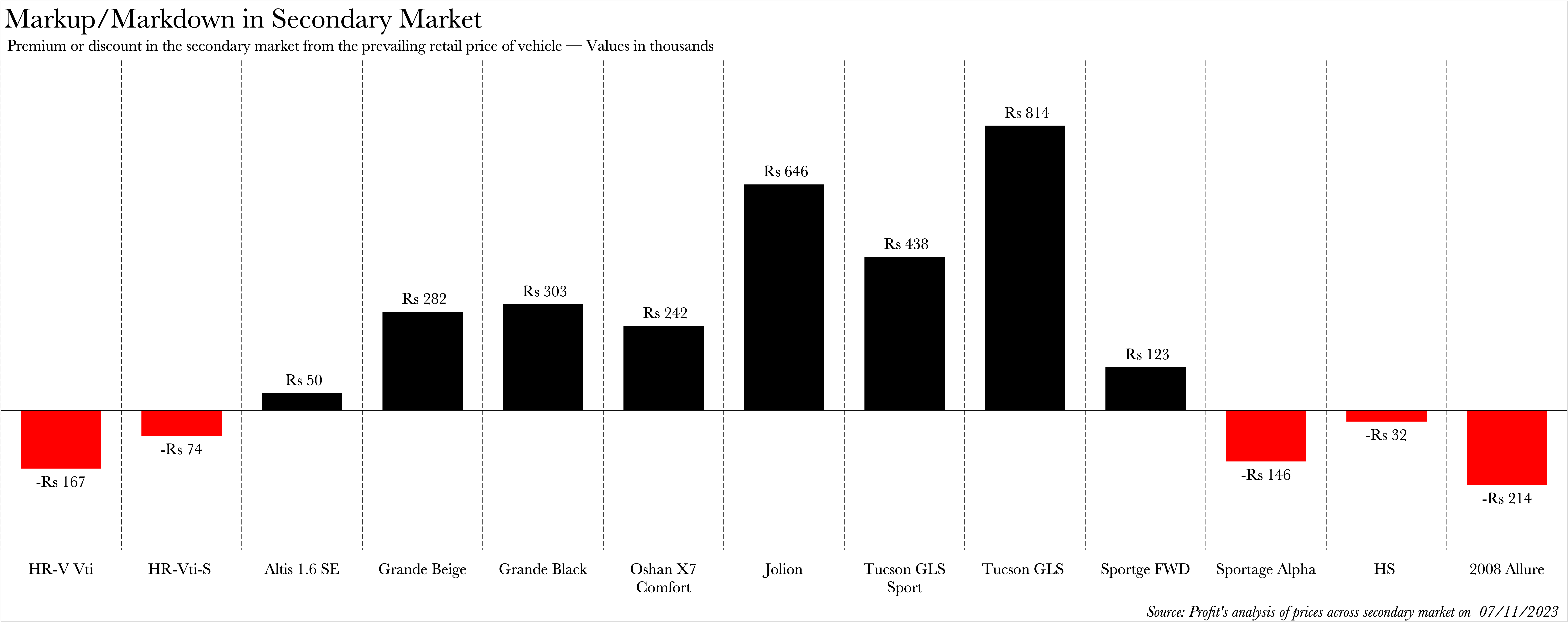 Out of the 13 vehicles, 8 traded at higher prices than their original ones. However, the HR-V models were not among them.
Out of the 13 vehicles, 8 traded at higher prices than their original ones. However, the HR-V models were not among them.
So, what led to the dismal situation of Honda’s HR-V?
Lacking the bite
“In my opinion, the HR-V was launched as a half-baked product,” declares Shaheel Shahzad, Co-founder of Bloombig Overdrive. “Chinese automakers provide more features such as driver assistance and panoramic sunroofs. In contrast, Honda has failed to equip the HR-V with even basic amenities like cruise control or a sunroof. Not to mention, but the 1.5L naturally aspirated engine is sluggish” Shahzad expounds.
When it comes to features, Shahzad’s argument holds water. A comparison of the HR-V with its potential rivals reveals that the HR-V Vti is second from the bottom, while the HR-V Vti-S is fourth from the bottom in terms of features across the range of vehicles. The only two vehicles that the HR-V manages to surpass — the Corolla Altis special edition and Hyundai Tucson GLS — are not only more economical but also larger in the case of the latter.
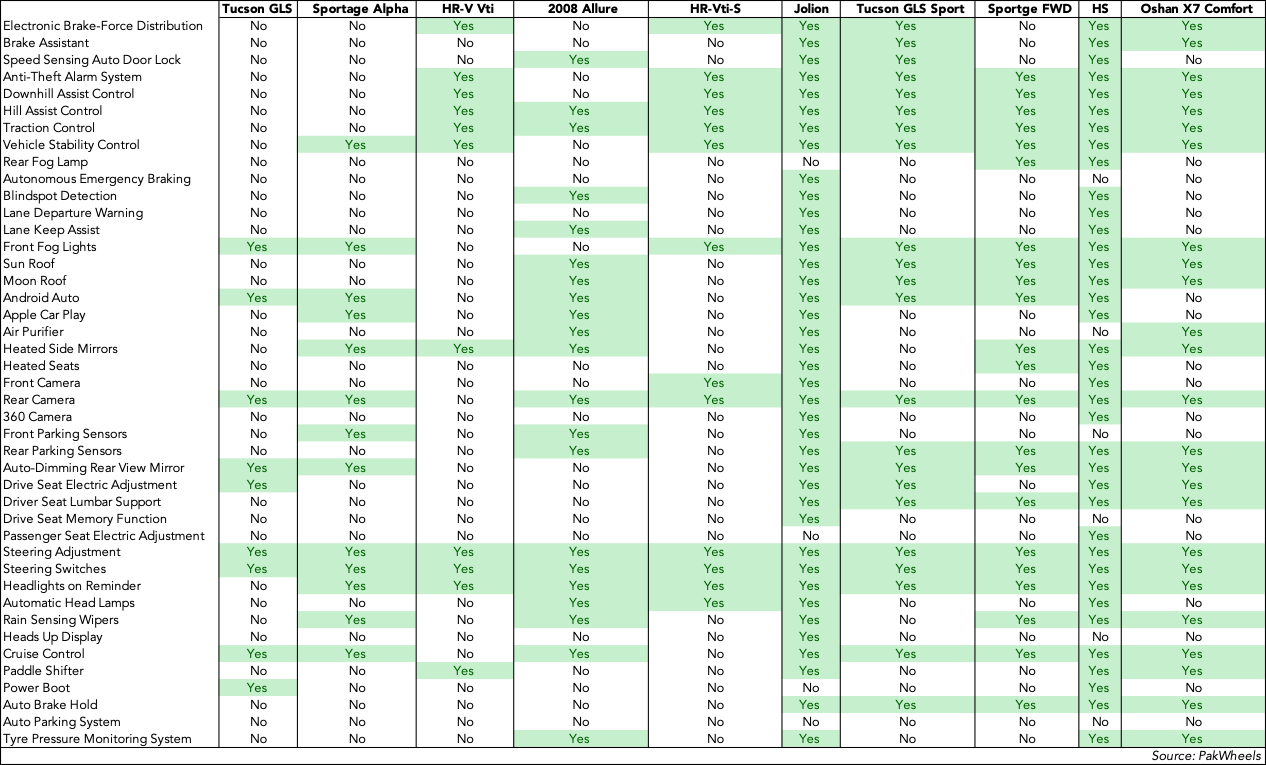 The HR-V’s shortcomings become glaringly apparent when we focus solely on the C-SUV segment. “The Sportage Alpha, with its cruise control, larger engine, and cabin size, is a better option in my view,” Shahzad adds. Although the HR-V’s only real competitor based on size alone is the Peugeot 2008, the HR-V is, on average, pricier than the Peugeot and sits squarely in the middle of C-segment C-SUVs across the board. This point is pivotal because while the difference in features is essentially an indictment against the HR-V, the size difference is of greater significance. It is perhaps the catalyst for the C-SUV market’s initial success.
The HR-V’s shortcomings become glaringly apparent when we focus solely on the C-SUV segment. “The Sportage Alpha, with its cruise control, larger engine, and cabin size, is a better option in my view,” Shahzad adds. Although the HR-V’s only real competitor based on size alone is the Peugeot 2008, the HR-V is, on average, pricier than the Peugeot and sits squarely in the middle of C-segment C-SUVs across the board. This point is pivotal because while the difference in features is essentially an indictment against the HR-V, the size difference is of greater significance. It is perhaps the catalyst for the C-SUV market’s initial success.
This publication has previously discussed how the dimensions and pricing of KIA’s Sportage—and its peers—have chipped away at the traditional sedan market.
Read more: Can KIA be King, or do the Big 3 have another trick up their sleeve?
The heart of the issue is that Pakistani customers have a preference for larger vehicles. While the HR-V is larger than some of the sedans it competes against, it is no longer the only player in the game. “The HR-V’s price range now offers a multitude of options. This is a stark contrast to the market in 2016 when the BR-V launched as the only locally manufactured seven-seater vehicle. Even if these competing vehicles only sell a few hundred units per model, it adds up. That’s market share being wrested away from Honda,” explicates Usman Ansari, Founder of CarSpiritPK.
However, Honda’s predicament may not be unique to Pakistan, at least according to Ansari. “On a global scale, the Japanese have been slow to respond to the C-SUV market. In stark contrast, the Europeans and Chinese have capitalised on it. As a result, while the Japanese have a smattering of models, the others have a veritable arsenal,” Ansari asserts.
Between a rock, and a hard place
An ostensibly straightforward solution for Honda to bolster its market presence could be to either slash the price of the vehicle or amplify its features. However, these alternatives are not as unambiguous as they appear. Trimming prices in Pakistan’s automotive market solely for the sake of sales is a venture fraught with risk. Your vehicle could emulate either the trajectory of the KIA Sorento or the Peugeot 2008. There’s an absence of certainty, and the hazards of having the former’s fate in your portfolio are something any car manufacturer would shudder at. As for augmenting features, they might merely inflate the cost and aggravate the predicament.
The quandary Honda faces bears a striking resemblance to the conundrum it grappled with from 2016 to 2018 with the predecessor of the HR-V. The only divergence is that the stakes have been raised this time around. Unlike in 2016, Honda has now ventured to manufacture the vehicle on Pakistani soil. Consequently, it has invested billions in the hope of the car’s success. This bold move comes at a time when every automotive titan has resolved to conquer the C-SUV market.
This is not to insinuate that Honda is oblivious to its challenges. The unexpected offering of 24-month interest-free instalments provides the company with an ingenious method of reducing prices without enduring the Sorento debacle themselves. However, if Honda has any trump card hidden up its sleeve, it might need to make its move sooner rather than later.




















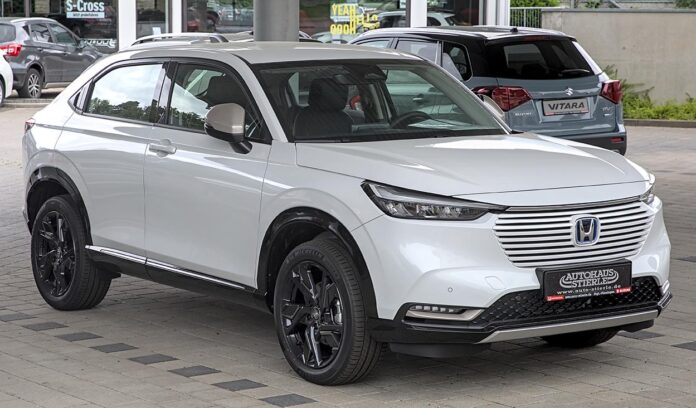





The Japanese automaker is facing a number of challenges, including rising costs, supply chain disruptions, and the increasing popularity of electric vehicles.
This should have been a hybrid from the beginning.
Sherazi group could have made a difference if they improved their battery company. I don’t see anyone going for Li-ion battery.
Would love to constantly get updated great blog
It’s my dream car. Nice information by the way
Wish all the features of Vezel should included in HR-V Soon
That is my dream car. I tried to save money to buy it.
Thank you for all the knowledge you distribute, Good post. I was very interested in the article, it’s quite inspiring I should admit. I like visiting you site since I always come across interesting articles like this one. Great Job!